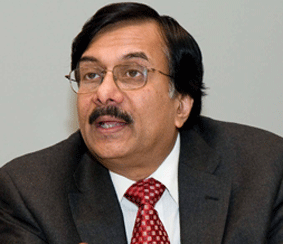What
Will Happen India 2010
If 2009 was a year when
the world moved ever so slowly, 2010 will be different, according to
stakeholders in the Indian air cargo sector.
 Positive
Outlook Positive
Outlook
Most optimistic and well-grounded view
of things here comes from Capt. Mukut Pathak, whose freight company
ACE is ready to start operations in three months.
Speaking to Air Cargo News FlyingTypers
he noted:
“What we feel about the market is
that in the months of January, February and March 2010, there will be
more consolidation of rates.
“The yields will improve while over-capacity
which is in the market would even out and then from the month of April
2010 onwards, we will hit the lean season.
“In that lean season, we do not
expect the yields and rates to fall as they did in 2009.
“The real rise will be seen from
July-August 2010 onwards.
“We expect that January-March 2011
onwards to reach the same point we were in 2008.
“If you look at the last 10-12 months
in the air cargo industry, the drop in air cargo has been so severe
that it has gone down to the levels of 2005.
“So, the industry has to first recover,
go back to the peak of 2008 and then the real rise will start.”
Recap 2009
Taking an industry view from the India
perspective 2009 saw top domestic air cargo and logistics majors all
lose business, while start-ups waiting on the sidelines had to delay
their launches.
Saddled with whopping losses, First Flight
Couriers Ltd, the second-largest courier in the country was forced to
abandon its cargo airline plans.
Reason: the company had selected an ATP
freighter that was unable to lift the expected tonnage.
On its heels was logistics major Gati,
which had tied up with Air India.
The company endured mounting losses as
it continued with its freighter business.
Crescent Air Cargo Services Pvt. Ltd,
that had planned to run Crescent Air, shut down its operations, again
due to accruing losses.
Waiting in the wings was Aryan Cargo Express
and Captain G R Gopinath’s Deccan 360.
Of these, Deccan 360 is up and about while
Aryan Cargo Express has planned its launch in March-April this year.
2010 Debuts
Change
 What
then will makes 2010 different? The focus will be on capacity building,
we are told. What
then will makes 2010 different? The focus will be on capacity building,
we are told.
As Civil Aviation Secretary Madhavan Nambiar
(right) put it to the delegates at the second India-U.S. Aviation Partnership
Summit held in Washington, D.C. (December 7-9, 2009): “Capacity
building is a vital need for Indian organizations.
“Through projects under the Joint
Aviation Steering Committee and the Aviation Cooperation Programme (ACP),
I am sure both countries would proactively execute the activities identified
in supporting civil aviation objectives.
“Some significant initiatives are
controller training, Air Traffic Flow Management planning, capacity
analysis of India’s airspace and cooperation in establishing proper
regulatory framework.
“Sharing of information, knowledge
and harmonization of systems will result in aviation appropriate solutions
in the best interests of the industry and the country.
“Adoption of best international
practices is the best way forward,” he concluded.
As 2010 opens India’s top airport
infrastructure provider, the Airports Authority of India (AAI) that
manages 126 airports, which include 11 international airports, 89 domestic
airports and 26 civil enclaves at military airfields, is upbeat.  Chairman
V P Agrawal (left) talking to ACNFT pointed
out: “The past year has indeed been challenging and
exciting”. Chairman
V P Agrawal (left) talking to ACNFT pointed
out: “The past year has indeed been challenging and
exciting”.
Having just completed his first year as
the head of AAI, Agrawal has steered the government-controlled organization
through the economic recession and even managed to implement a few of
the planned projects of upgradation and development of airports.
“In this period (the last year)
the seed of modernization that we had sown started to germinate and
the projects at 21 airports (nine non-metro and 12 other airports) were
completed.”
As for air cargo, the airports under the
AAI (the list does not included the five privately-held airports at
Delhi, Mumbai, Hyderabad, Bangalore and Cochin) handled in 2009, 1.14
million tons of exports and 0.54 million tons of domestic cargo. The
AAI chief mentioned that there had been an upward trend in international
cargo over the last few years from 2005-06: averaging 11 percent per
year.
Mr. Agrawal said that the AAI has planned
out major projects in two of the metro airports under its command: Chennai
and Kolkata.
In Chennai, for example, the cargo complex
had seen the creation of storage/processing area of 15,600 sq meters.
“AAI is going to add an area of
26,000 sq m. to increase the capacity by 501890 MTs.
“This capacity will be sufficient
to handle the cargo up to the year 2019-20.
“As for Kolkata, the old cargo terminal
with an area of 4,000 sqm. had been converted into a separate exclusive
domestic/courier terminal.
“The AAI is also moving ahead to
create Centers for Perishable Cargo (CPC) at Delhi, Chennai, Hyderabad,
Mumbai, Amritsar and Kolkata.
“Although perishable cargo has not
shown any appreciable growth, the present facilities are yet to be utilized
to full potential and will meet any future requirements for handling
of perishable cargo at the airports.”
With the major upgrading process underway,
the air cargo growth that AAI was looking forward to in 2010 is around
six percent. Mr. Agrawal said.
“As per our study and projections,
there will be cargo growth of 6% in the year 2010-11. A growth of 8
percent on the international sector and 6 per cent on the domestic sector
is expected between 2010 and 2017.”
The optimism of the AAI has rubbed off
on other operators too.
Cans On The
Rise
The government-run Container Corporation
of India (CONCOR) that had decided to set up air freight stations quite
some time ago, has now said that two air freight stations (of the seven
planned) will be created by April 2010.
CONCOR has tied up with Cargo Services
Centre for air cargo handling, warehousing and cargo security services.
New Ventures
Private operators too are ready to fly
high.
One of those rare outfits that has braved
the recession is homegrown express major Blue Dart.
 Anil
Khanna, Managing Director, Blue Dart Express said that 2009 for the
air express industry could be described as extremely challenging. Anil
Khanna, Managing Director, Blue Dart Express said that 2009 for the
air express industry could be described as extremely challenging.
"These are tough times . . . We believe
that these inconsistencies will bottom out with the revival of the economy."
But the company kept to its expansion
plans, opening a new warehouse at the Hyderabad airport in December
2009 and is well ahead in its plans to set up another at Delhi airport
this year.
“Blue Dart is all set to improve
and enhance its existing aviation network, especially in the North-east
region of the country.
“However we are holding back as
far as inducting more freighters in our seven-strong Boeing fleet,”
Anil Khanna said.
With the $625-million domestic express
cargo market forecast to grow at 20 percent over the next five years,
Capt. G R Gopinath, who started his Deccan 360 last year, had been looking
around to expand but had stopped short because of a lack of funds.
He has decided to sell 25 percent stake
in his Deccan 360, now that the markets have revived and the valuation
of his enterprise had reached around Rs 800 crore (USD$200 million).
The Deccan 360 boss had abandoned talks
in September 2009 due to low valuations.
According to insiders privy to the talks
with European and U.S. investors, Deccan 360 plans to hire 5,000 staffers
in the next five years and also appoint 100 franchisees.
 Air
India Struggling Air
India Struggling
Elsewhere as 2010 begins, a troubled Air
India has taken the decision to hive off its ground handling and cargo
operations into separate business units.
Arvind Jadhav, CMD, Air India told ACN/FT:
“We already have three registered
companies that will operate the three SBUs (Special Business Units)
separately from the beginning of coming financial year.
“The new unit handling cargo operations
will offer logistics services for door-to- door deliveries and is expected
to generate Rs 2,000 crore of revenues in 2010.”
Who Cuts The
Cheese?
Looking across the table India’s freight forwarders who had a
rough 2009 are keen to break out.
According to Bangalore-based Sesh Kulkarni, President of UT Worldwide,
and a prominent member of the Bangalore Air Cargo Club (BACC),:
 “Last year (2009) gave most companies a good chance of introspecting
and knowing the strengths of their teams.
“Last year (2009) gave most companies a good chance of introspecting
and knowing the strengths of their teams.
“As we embark on establishing the difference between the chalk
and the cheese (quality), it will create a flutter in the trade, it
will be interesting to see how companies will deal with the always in
short supply cheese internally and how companies will identify cheese
externally.”
“We see 2010 as the ‘Year of
Hope’ and “we are particularly very excited as there is
some sanity, which is building around in the system.
“While not everything has fallen in place, the strength of Indian
domestic economy and the course corrections taken by various countries
and industries has brought to the front – some realistic expectations.
“We think that 2010 will be a better year than 2009 and we foresee
growth,” said Kulkarni.
He went on to add: “I would attribute 2010 also as a year of reinvention
both for business and business practices.
“Our industry is not very matured on all these fronts, but I guess,
the writing is on the wall, and the companies which are here to stay,
will have to look at this.”
Tirthankar Ghosh |




